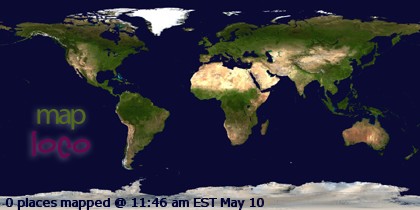A few more glacier bay photos. Here we're up at the head of Tarr Inlet, looking at the Margerie glacier:


This is a meltwater stream that runs underneath the glacier. When it hits the salt water, it's so much less dense, because it's fresh, that it boils to the surface. Due to the miracle of stop-action photography, it just looks like a kind of frizzy sponge to the right where the glacier meets the water, but you can get the general idea. The seagulls that are flocking around this upwelling are there because the upwelling brings up critters from below - it's a shrimp buffet for the seagulls.

This is the Melburn glacier, which dumps out at the top of the same inlet as the Margerie glacier. Notice the slightly darker color. Dunno why this is - I sort of suspect that this glacier is receding and the other one isn't, or maybe it's just that the other one is moving a lot faster.

The water is this color throughout the park. The photo doesn't really do it justice - it frankly looks like it had to have been airbrushed on. There's no way anything natural could ever be such a perfect color.

We're now heading due west on open ocean across the Gulf of Alaska on our way to Prince William Sound and College Fjord, making full speed, which is something like 23 knots, or about 26.5 mph. This is the first time we've had no land in sight to the port or starboard on the whole trip. Fortunately, at least so far the ocean is very gentle. We actually had much more exciting swells on Wednesday night.
The quality of light in the summer at night is amazing. It's a kind of light you very rarely see further south, because it's basically twilight from 10:30 at night until 4am, when the sun rises. So you can really see quite clearly, but it's very very dark - it's only because the human eye has such amazing range that you can see anything.
But what you see above is blue sky peeking through dark cloud. Land masses show up clearly delineated, but so dark that they're nearly black. It's really eerily beautiful. It has a bit of the feel of a dark charcoal drawing of a nighttime scene in an old victorian book, except in color. The camera can't capture it because there isn't enough light - unlike the pictures I took at twilight on the way north from Ketchikan, when I tried to take a picture in this light it just came out black.
I spent a bit of time on the prow of the boat during the day today, just watching the ocean go by. It has much the same feel as being on the prow at night, but of course all the light changes everything. If it weren't for the snow everywhere, I would swear we were on the Mediterranean sea. The coldest it ever got today was at the head of Tarr Inlet when we went by the Margerie glacier, and that wasn't very challenging at all. When I shot the last picture above, it just felt warm and sunny on the deck, with a cool, gentle breeze to keep it comfortable.


This is a meltwater stream that runs underneath the glacier. When it hits the salt water, it's so much less dense, because it's fresh, that it boils to the surface. Due to the miracle of stop-action photography, it just looks like a kind of frizzy sponge to the right where the glacier meets the water, but you can get the general idea. The seagulls that are flocking around this upwelling are there because the upwelling brings up critters from below - it's a shrimp buffet for the seagulls.

This is the Melburn glacier, which dumps out at the top of the same inlet as the Margerie glacier. Notice the slightly darker color. Dunno why this is - I sort of suspect that this glacier is receding and the other one isn't, or maybe it's just that the other one is moving a lot faster.

The water is this color throughout the park. The photo doesn't really do it justice - it frankly looks like it had to have been airbrushed on. There's no way anything natural could ever be such a perfect color.

We're now heading due west on open ocean across the Gulf of Alaska on our way to Prince William Sound and College Fjord, making full speed, which is something like 23 knots, or about 26.5 mph. This is the first time we've had no land in sight to the port or starboard on the whole trip. Fortunately, at least so far the ocean is very gentle. We actually had much more exciting swells on Wednesday night.
The quality of light in the summer at night is amazing. It's a kind of light you very rarely see further south, because it's basically twilight from 10:30 at night until 4am, when the sun rises. So you can really see quite clearly, but it's very very dark - it's only because the human eye has such amazing range that you can see anything.
But what you see above is blue sky peeking through dark cloud. Land masses show up clearly delineated, but so dark that they're nearly black. It's really eerily beautiful. It has a bit of the feel of a dark charcoal drawing of a nighttime scene in an old victorian book, except in color. The camera can't capture it because there isn't enough light - unlike the pictures I took at twilight on the way north from Ketchikan, when I tried to take a picture in this light it just came out black.
I spent a bit of time on the prow of the boat during the day today, just watching the ocean go by. It has much the same feel as being on the prow at night, but of course all the light changes everything. If it weren't for the snow everywhere, I would swear we were on the Mediterranean sea. The coldest it ever got today was at the head of Tarr Inlet when we went by the Margerie glacier, and that wasn't very challenging at all. When I shot the last picture above, it just felt warm and sunny on the deck, with a cool, gentle breeze to keep it comfortable.



2 Comments:
110* by Sunday. Just keeping you informed.
You're too kind. We're back now, so I guess we'll be suffering the 110º heat with you. Come over for coffee if you want! :')
Post a Comment
<< Home